Abstract
Regarding turnips, Japan’s main root vegetable, based on data for 2022, the national turnip harvest is 105kt and the cultivated area is 3.87kha. The largest shipment volume was in Chiba Prefecture at 26kt. As can be seen from these figures, turnip production in Japan is widespread throughout the country, with Chiba Prefecture in particular being one of the production centers. One indicator of high demand for turnips is the size of the shipping volume. Turnips are a traditional Japanese food ingredient, and demand is likely to be increasing due to growing health consciousness and changes in food culture. These data indicate that Japanese agriculture is responding to the demand for root vegetables, with turnips occupying an important position.
Turnip harvest yield (main data).
Japan’s turnip harvest has fluctuated between 1973 and 2022. The peak was 217kt in 1987, and has since declined to 105kt in 2022. This is roughly half of the peak yield, a decline of 48.5%. This trend reflects changes in the demand for and production structure of root vegetables in Japanese agriculture. Possible reasons include changes in demand due to urbanization and changing food culture, the impact of agricultural policies, and climate change. Competition from other vegetables and ingredients may also be a factor. The data shows a clear trend of turnip yields declining from their peak, but there are likely several factors at play here.
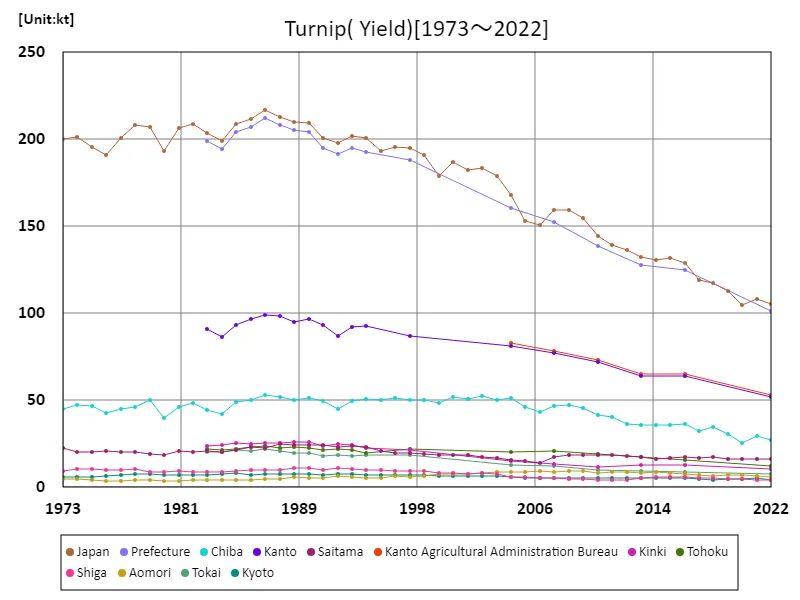

The maximum is 217kt[1987] of Japan, and the current value is about 48.5%
Turnip harvest volume (by prefecture).
According to data from 2022, Chiba recorded the highest harvest of root vegetables by prefecture at 27.4kt, the highest overall. A notable feature that can be seen from this data is that Chiba Prefecture stands out in the production of root vegetables. Chiba Prefecture is geographically blessed with fertile soil and favorable climatic conditions, making it an ideal environment for growing root vegetables. It is also possible that technological innovation and supporting agricultural policies have led to improved production efficiency. On the other hand, yields in other regions are relatively low, suggesting that there are disparities in productivity between regions. These characteristics demonstrate the regional differences and uneven distribution of productivity in Japanese agriculture. In the future, it will be important to improve productivity and promote sustainable agriculture in each region.
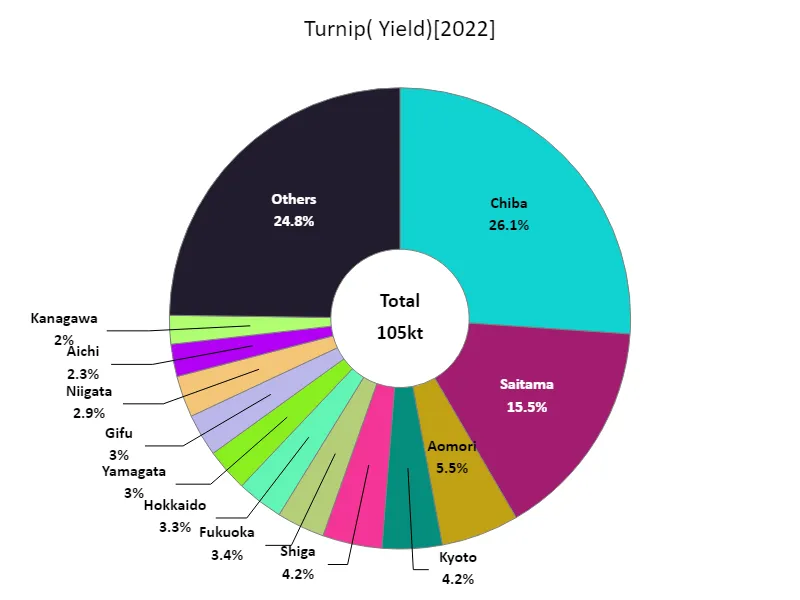

The maximum is 27.4kt of Chiba, the average is 2.24kt, and the total is 105kt
Turnip cultivation area (main data).
The area of turnip cultivation in Japan has fluctuated between 1973 and 2022. The peak was 7.9kha nationwide in 1973, but it has since decreased and is currently at 3.87kha, which is 49% of the peak. This trend reflects changes in Japan’s agricultural structure and market demand. The area under cultivation may be shrinking due to increasing urbanization and a declining agricultural labor force. Changing consumer eating habits and competition from other vegetables may also be contributing factors. On the other hand, despite the declining trend, demand for root vegetables remains strong, and producers are working to improve efficiency and quality. Against this background, while there has been a decrease in the area of turnip cultivation, it can be assumed that changes to the production system are being made to meet demand. In the future, it will be necessary to establish an efficient and sustainable root vegetable production system that maintains a balance between supply and demand.
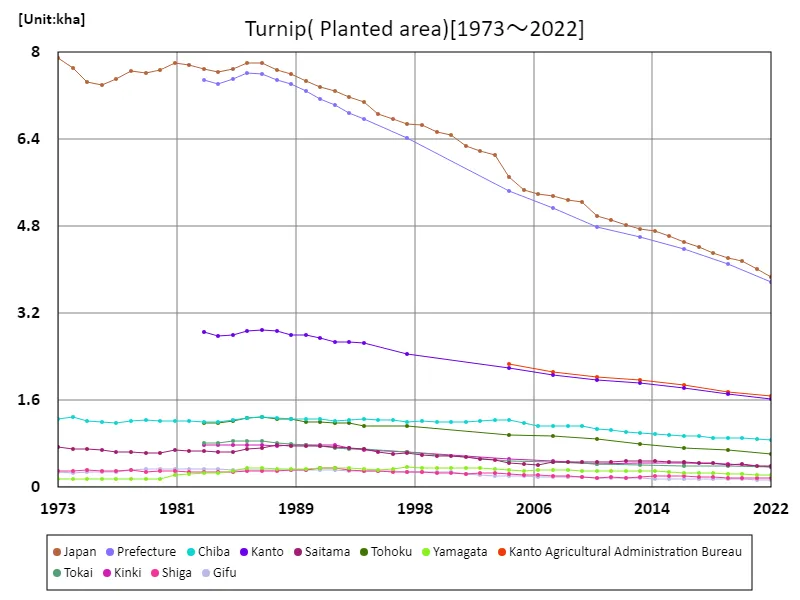

The maximum is 7.9kha[1973] of Japan, and the current value is about 49%
Turnip cultivation area (by prefecture).
According to data from 2022, the largest area cultivated with root vegetables in Japan is in Chiba Prefecture at 863 hectares, which is the largest amount overall. A notable feature that can be seen from these figures is that Chiba Prefecture stands out in the production of root vegetables. One reason for this is thought to be that Chiba Prefecture’s geographical conditions and climate are suitable for cultivating root vegetables. It is also possible that farmers and agricultural organizations in Chiba Prefecture are sharing technology and know-how to improve production efficiency. On the other hand, the area under cultivation in other regions is relatively small, suggesting that there are disparities in productivity between regions. These characteristics demonstrate the regional differences and uneven distribution of productivity in Japanese agriculture. In the future, it will be important to improve productivity and promote sustainable agriculture in each region.
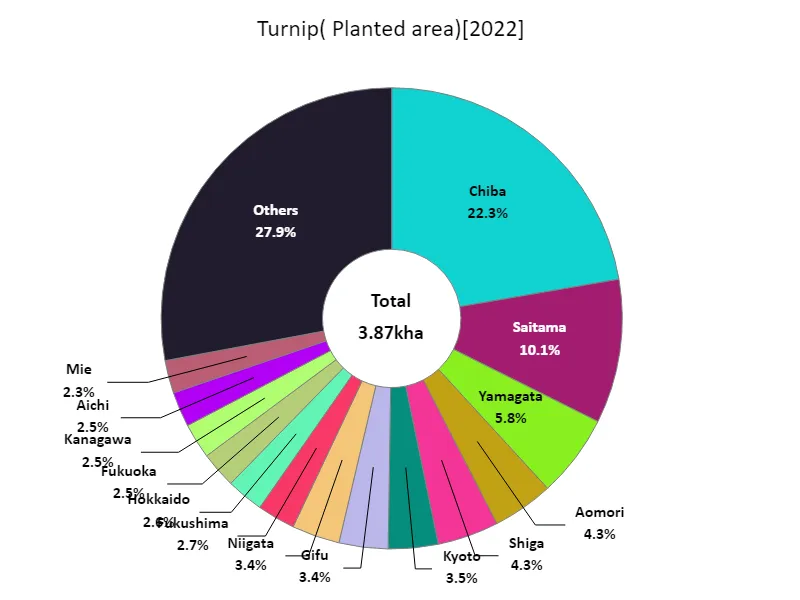

The maximum is 863ha of Chiba, the average is 82.4ha, and the total is 3.87kha
Turnip shipment volume.
According to data for 2022, Japan’s total turnip shipments were 87.9kt, of which Chiba Prefecture accounted for 26kt, the largest proportion. Additionally, the average turnip shipment is 1.87kt. A notable feature that can be seen from this data is that Chiba Prefecture stands out in turnip production. Chiba Prefecture has climate conditions and soil suitable for growing turnips, and there is a possibility that there is progress in sharing technology and know-how among producers. On the other hand, shipments from other regions are relatively small, suggesting disparities in production capacity between regions. In addition, the total shipping volume of 87.9kt indicates that turnips are one of the important root vegetables in Japan. It can be assumed that demand is stable and is rooted in consumers’ eating habits. In the future, there will be a need to improve productivity in each region and establish a production system that matches demand.
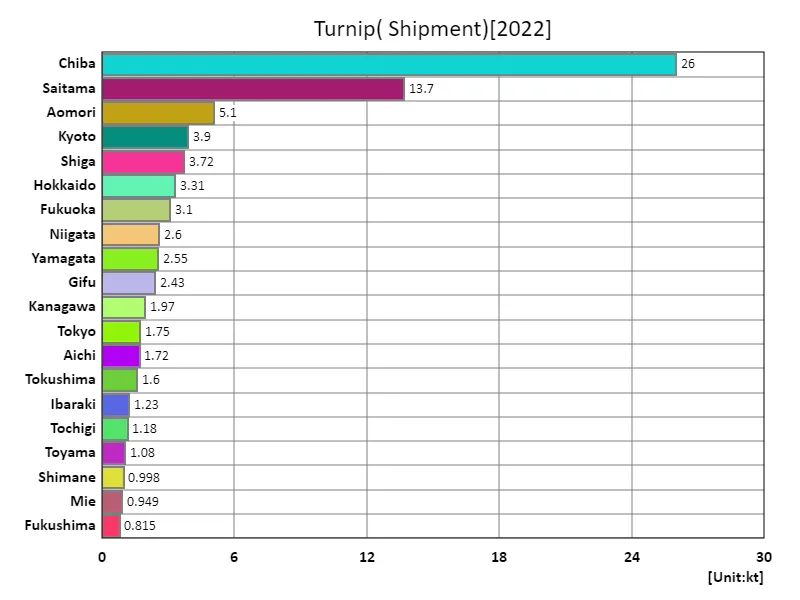

The maximum is 26kt of Chiba, the average is 1.87kt, and the total is 87.9kt
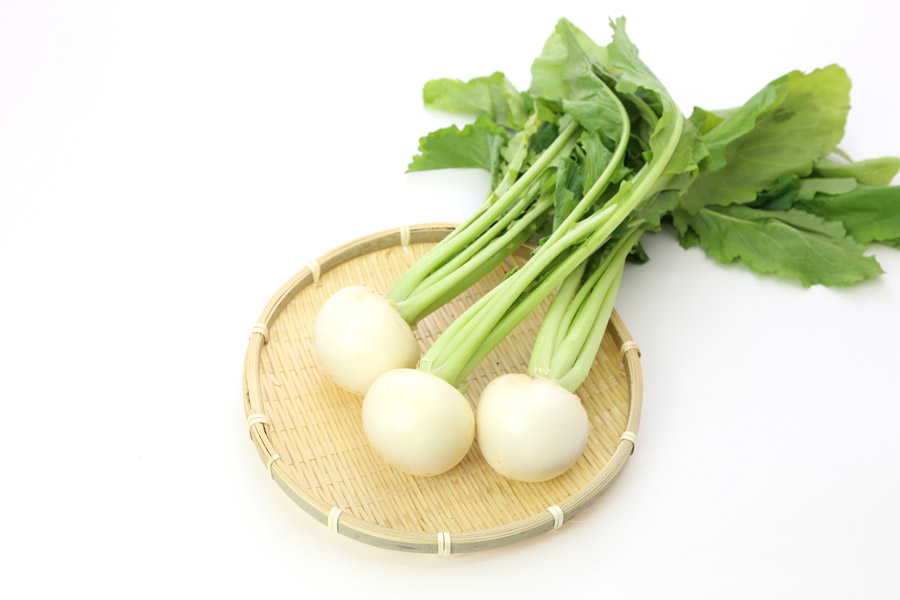


Comments